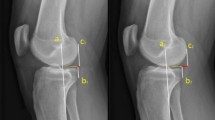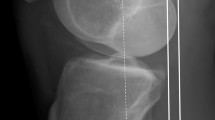Abstract
Purpose
The purpose of the study was to determine the correlation between medial tibial slope (MTS) and anterior tibial translation (ATT) in female patients with an ACL-deficient knee. It was hypothesized that female patients with a greater medial tibial slope had an increased anterior tibial translation compared to males.
Methods
MTS and ATT were analysed in 276 patients (138 females and 138 males) with a complete ACL rupture from 2012 to 2016. The mean age was 32 ± 12 years. Previous surgery or additional ligament injury was excluded. CT scan was used for measuring MTS. Meniscal findings were reported. Anterior tibial translation and side to side difference (SSD) were measured by bilateral Telos™ stress radiography with knee flexion of 20°.
Results
There was no significant difference in ATT between females (5.4 ± 3.9) and males (5.8 ± 4.2), nor was there a difference in MTS between females (9.8 ± 2.8) and males (9.8 ± 2.7). A positive correlation was found between MTS and ATT absolute (r = 0.35, p < 0.001) and side to side difference (r = 0.12, p = 0.03). MTS greater or equal to 11° significantly increased the ATT (p < 0.05). For each degree of increase of the MTS, increases in ATT absolute of 0.6 mm and SSD of 0.18 mm were observed. Greater MTS was identified as a risk factor for an increase of ATT in females (r = 0.37, p < 0.001) but not in males (r = − 0.1, n.s). Increases of 1° of MTS increased ATT 0.57 mm in female patients (p < 0.001). MTS was influential in ATT despite the presence (r = 0.28 [0.11, 0.44], p = 0.001) or absence (r = 0.48 [0.35, 0.6], p < 0.001) of meniscal lesions.
Conclusions
Greater medial tibial slope is associated with increased anterior tibial translation in females with ACL-deficient knees compared to males, despite the presence or absence of meniscal lesions. This could be due to a quadriceps/hamstring imbalance in females and the ability of the hamstring muscles to moderate ATT.
Level of evidence
III.




Similar content being viewed by others
Abbreviations
- ACL:
-
Anterior cruciate ligament
- MTS:
-
Medial tibial slope
- ATT:
-
Anterior tibial translation
- SSD:
-
Side-to-side difference
- IKDC:
-
International Knee Documentation Committee
- PTAA:
-
Proximal tibial anatomic axis
- ICC:
-
Intra-class correlation
References
Beldame J, Bertiaux S, Roussignol X, Lefebvre B, Adam JM, Mouilhade F, Dujardin F (2011) Laxity measurements using stress radiography to assess anterior cruciate ligament tears. Orthop Traumatol Surg Res 97(1):34–43
Boyer P, Djian P, Christel P, Paoletti X, Degeorges R (2005) Reliability of the KT-1000 arthrometer (Medmetric) for measuring anterior knee laxity: comparison with Telos in 147 knees. Rev Chir Orthop Reparatrice Appar Mot 90(8):757–764
Dejour H, Bonnin M (1994) Tibial translation after anterior cruciate ligament rupture. Two radiological tests compared. J Bone Jt Surg Br 76(5):745–749
Dejour D, Pungitore M, Valluy J, Nover L, Saffarini M, Demey G (2018) Preoperative laxity in ACL-deficient knees increases with posterior tibial slope and medial meniscal tears. Knee Surg Sports Traumatol Arthrosc 27(2):564–572
Galano GJ, Suero EM, Citak M, Wickiewicz T, Pearle AD (2012) Relationship of native tibial plateau anatomy with stability testing in the anterior cruciate ligament-deficient knee. Knee Surg Sports Traumatol Arthrosc 20(11):2220–2224
Giffin JR, Stabile KJ, Zantop T, Vogrin TM, Woo SL, Harner CD (2007) Importance of tibial slope for stability of the posterior cruciate ligament deficient knee. Am J Sports Med 35(9):1443–1449
Hashemi J, Chandrashekar N, Mansouri H, Gill B, Slauterbeck JR, Schutt RC Jr, Dabezies E, Beynnon BD (2010) Shallow medial tibial plateau and steep medial and lateral tibial slopes: new risk factors for anterior cruciate ligament injuries. Am J Sports Med 38(1):54–62
Helito CP, Helito PV, Costa HP et al (2014) MRI evaluation of the anterolateral ligament of the knee: assessment in routine 1.5-T scans. Skeletal Radiol 43(10):1421–1427
Hohmann E, Bryant A, Reaburn P, Tetsworth K (2010) Does posterior tibial slope influence knee functionality in the anterior cruciate ligament-deficient and anterior cruciate ligament-reconstructed knee? Arthroscopy 26(11):1496–1502
Hohmann E, Bryant A, Reaburn P, Tetsworth K (2011) Is there a correlation between posterior tibial slope and non-contact anterior cruciate ligament injuries? Knee Surg Sports Traumatol Arthrosc 19(Suppl 1):S109–114
Jardin C, Chantelot C, Migaud H, Gougeon F, Debroucker M, Duquennoy A (1999) Reliability of the KT-1000 arthrometer in measuring anterior laxity of the knee: comparative analysis with Telos of 48 reconstructions of the anterior cruciate ligament and intra-and interobserver reproducibility. Rev Chir Orthop Reparatrice Appar Mot 85(7):698–707
Kessler M, Burkart A, Martinek V, Beer A, Imhoff A (2003) Development of a 3-dimensional method to determine the tibial slope with multislice-CT. Z Orthop Ihre Grenzgeb 141(2):143–147
Li Y, Hong L, Feng H, Wang Q, Zhang J, Song G, Chen X, Zhuo H (2014) Posterior tibial slope influences static anterior tibial translation in anterior cruciate ligament reconstruction: a minimum 2-year follow-up study. Am J Sports Med 42(4):927–933
Liu W, Maitland ME (2003) Influence of anthropometric and mechanical variations on functional instability in the ACL-deficient knee. Ann Biomed Eng 31(10):1153–1161
Lustig S, Scholes CJ, Leo SP, Coolican M, Parker DA (2013) Influence of soft tissues on the proximal bony tibial slope measured with two-dimensional MRI. Knee Surg Sports Traumatol Arthrosc 21(2):372–379
McNair PJ, Wood GA, Marshall RN (1992) Stiffness of the hamstring muscles and its relationship to function in anterior cruciate ligament deficient individuals. Clin Biomech (Bristol, Avon) 7(3):131–137
Panisset JC, Ntagiopoulos PG, Saggin PR, Dejour D (2012) A comparison of Telos stress radiography versus Rolimeter in the diagnosis of different patterns of anterior cruciate ligament tears. Orthop Traumatol Surg Res 98(7):751–758
Ryan J, Magnussen RA, Cox CL, Hurbanek JG, Flanigan DC, Kaeding CC (2014) ACL reconstruction: do outcomes differ by sex? A systematic review. J Bone Jt Surg Am 96(6):507–512
Sauer S, Clatworthy M (2018) The effect of medial tibial slope on anterior tibial translation and short-term ACL reconstruction outcome. Surg J (N Y) 4(3):e160–e163
Schneider A, Si-Mohamed S, Magnussen RA, Lustig S, Neyret P, Servien E (2018) Tibiofemoral joint congruence is lower in females with ACL injuries than males with ACL injuries. Knee Surg Sports Traumatol Arthrosc 26(5):1375–1383
Snaebjornsson T, Hamrin Senorski E, Sundemo D, Svantesson E, Westin O, Musahl V, Alentorn-Geli E, Samuelsson K (2017) Adolescents and female patients are at increased risk for contralateral anterior cruciate ligament reconstruction: a cohort study from the Swedish National Knee Ligament Register based on 17,682 patients. Knee Surg Sports Traumatol Arthrosc 25(12):3938–3944
Southam BR, Colosimo AJ, Grawe B (2018) Underappreciated factors to consider in revision anterior cruciate ligament reconstruction: a current concepts review. Orthop J Sports Med. 6(1):2325967117751689. https://doi.org/10.1177/2325967117751689
Tan SH, Lau BP, Khin LW, Lingaraj K (2016) The Importance of patient sex in the outcomes of anterior cruciate ligament reconstructions: a systematic review and meta-analysis. Am J Sports Med 44(1):242–254
Todd MS, Lalliss S, Garcia E, DeBerardino TM, Cameron KL (2010) The relationship between posterior tibial slope and anterior cruciate ligament injuries. Am J Sports Med 38(1):63–67
Trojani C, Sbihi A, Djian P et al (2011) Causes for failure of ACL reconstruction and influence of meniscectomies after revision. Knee Surg Sports Traumatol Arthrosc 19(2):196–201
Utzschneider S, Goettinger M, Weber P, Horng A, Glaser C, Jansson V, Muller PE (2011) Development and validation of a new method for the radiologic measurement of the tibial slope. Knee Surg Sports Traumatol Arthrosc 19(10):1643–1648
Vacek PM, Slauterbeck JR, Tourville TW et al (2016) Multivariate analysis of the risk factors for first-time noncontact ACL injury in high school and college athletes: a prospective cohort study with a nested, matched case-control analysis. Am J Sports Med 44(6):1492–1501
Webb JM, Salmon LJ, Leclerc E, Pinczewski LA, Roe JP (2013) Posterior tibial slope and further anterior cruciate ligament injuries in the anterior cruciate ligament–reconstructed patient. Am J Sports Med 41(12):2800–2804
Yue DB, Wang BL, Wang WG, Guo WS, Zhang QD (2013) Effects of posterior tibial slope on non-contact anterior cruciate ligament rupture and stability of anterior cruciate ligament rupture knee. Zhonghua yi xue za zhi 93(17):1309–1312
Zelisko JA, Noble HB, Porter M (1982) A comparison of men's and women's professional basketball injuries. Am J Sports Med 10(5):297–299
Zeng C, Yang T, Wu S et al (2016) Is posterior tibial slope associated with noncontact anterior cruciate ligament injury? Knee Surg Sports Traumatol Arthrosc 24(3):830–837
Funding
No external source of funding was used.
Author information
Authors and Affiliations
Contributions
AS participated in the design of the study, acquisition and interpretation of the data. CAC helped to evaluate the inter-observer reliability and helped to translate the manuscript in English. CB helped to translate the manuscript in English. RG has made substantial contribution to the conception of the study. SL has given final approval of the version to be published. ES has given final approval of the version to be published.
Corresponding author
Ethics declarations
Conflict of interest
On behalf of all authors, the corresponding author states that there is no conflict of interest.
Ethical approval
This study was approved by our institutional review board.
Informed consent
Patients gave informed consent that data would be published.
Additional information
Publisher's Note
Springer Nature remains neutral with regard to jurisdictional claims in published maps and institutional affiliations.
Rights and permissions
About this article
Cite this article
Schneider, A., Arias, C., Bankhead, C. et al. Greater medial tibial slope is associated with increased anterior tibial translation in females with an ACL-deficient knee. Knee Surg Sports Traumatol Arthrosc 28, 1901–1908 (2020). https://doi.org/10.1007/s00167-019-05643-8
Received:
Accepted:
Published:
Issue Date:
DOI: https://doi.org/10.1007/s00167-019-05643-8




